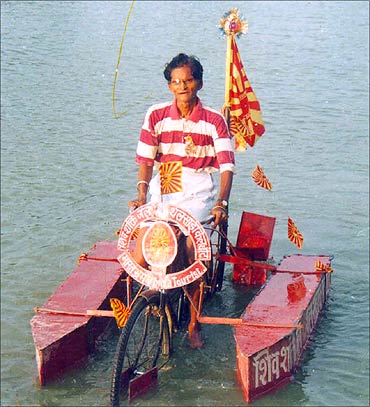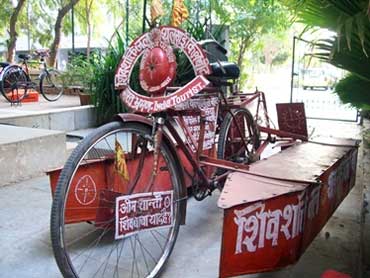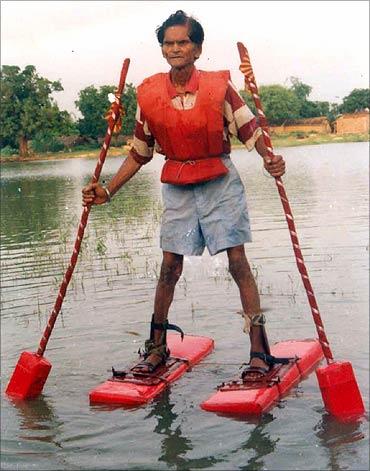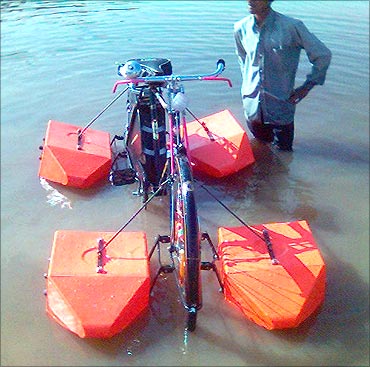 |
You can move on land and water with ease, thanks to these bicycles designed by Dwarka Prasad Chaurasiya andMohammed Saidullah about three decades back.
While people opted to stay indoors during the floods, Dwaraka and Saidullah changed their bicycles into amphibious vehicles to stay afloat in the raging waters!
Unfortunately, there have been no takers for these low-cost innovations that can be very handy during floods even today. They could also be used in amusement parks or children's parks, for travelling across a flooded river, for removing aquatic weeds, or dragging a raft carrying goods, etc.
After seeing Saidullah's amphibious bicycle, the then President APJ Abdul Kalam remarked that it could be used by defence personnel as well. Saidullah has received the National Innovation Foundation's (NIF) lifetime achievement award for this and many other innovations of his.
He was also selected as one of the 12 finalists for the prestigious Wall Street Journal Asian Innovation Awards. Despite the awards and accolades, both the innovators remain impoverished. Today, Saidullah sells honey to earn his livelihood.
Here's the inspiring story of two versatile innovators. . .
Text and photographs, courtesy: National Innovation Foundation
Image: Dwarka Prasad in the amphibious cycle.
http://www.rediff.com/business/slide-show/slide-show-1-innovation-amphibious-cycles-from-indian-innovators/20100803.htm
 |
The amphibious wonder
Mohammed Saidullah grew up in a small village called Jatva-Jeneva (Purvi Champaran) of Motihari district, Bihar.
He started displaying this amphibious wonder from Mirzapur to Allahabad, from Kanpur and Bitthur to Kanauj to reach Delhi, and then on to Ajmer, Mount Abu, Rajkot, and Porbandar and then to Bet Dwarka (Okha) where he crossed a stretch of five kilometres in high seas. He was taken to a nearby temple and the priests performed an 'aarti' on him.
Buoyed by the success he received, he came to Ahmedabad and demonstrated his cycle at Kankaria Lake in 1980 where tens of thousands witnessed his feat.
The then chief minister of Gujarat gave him an honorarium for his achievement. He then performed in Vadodara and moved to Mumbai for his next performance. In Mumbai, he travelled from Juhu to Nariman Point on the sea and from the Gateway of India to the Elephanta Caves, a stretch of over 11 kilometres in sea, which tested his mental and physical strength.
Click NEXT to read more...
 |
Water walker
Dwarka Prasad, also made shoes of thermocol in 1982, which could be used to skate or walk on water. After lot of trials with different shapes and sizes finally, he came up with the first prototype of the water shoes, which were 5 feet long and 4.5 inches wide.
This first attempt was unsuccessful but he was undeterred. After a series of failures, finally he managed to standardize the size to 3 feet in length, 10 inches in width and 8 inches in thickness. This size gave him good buoyancy and ease in maneuvering. Once he had this ready, he went to Delhi to try performing at the Asiad Games but he was not allowed.
He stayed there for a considerable period of time and finally performed at the Delhi Boat Club, which was widely covered by the media. He was also interviewed by BBC during that trip, which was great recognition for him. Since then the shoes have been with him and sometimes he performs on reques
Dwarka Prasad uses large specially designed shoes filled with thermocol fitted to each foot and oars filled with thermocol to walk on water. Use of lightweight thermocol gives the desired buoyancy.
The shoes for walking on water consist of two floats made of thermocol, bonded to a rexine sheet. This whole unit is attached to metal straps with back foot support. These two individual shoes are also tied to each other to prevent them from going too far apart beyond one's ability to steer or navigate them.
One needs a pair of hand held oars for balancing while walking in water. Awarded by the then President A P J Abdul Kalam in 2007, Dwarka Prasad dreams of crossing the English Channel one day, despite his old age and precarious economic condition.
One needs a pair of hand held oars for balancing while walking in water. Awarded by the then President A P J Abdul Kalam in 2007, Dwarka Prasad dreams of crossing the English Channel one day, despite his old age and precarious economic condition.
Click NEXT to read Mohammed Saidullah's tryst with innovations
Saidullah has studied up to the tenth standard in Ramsingh Chatuani in Gajpura but could not complete his studies due to poor financial condition. He married Noor Jahan in 1960 and has three children.
Every innovation of his has been named after his wife, Noor. Thus, we have the 'Noor bicycle', the 'Noor Rahat' electric power house', the 'Noor water pump', etc. Mohd. Saidullah lives with his daughters in Mathia Deah village in Purvi Champaran (Motihari).
Unfortunately his love for innovations has been at a personal cost as Saidullah has sold all of his 40 acres of land in pursuit of his innovations and his generosity. Today, he moves around on his bicycle from place to place and sells honey to earn his livelihood but his passion for innovations remains alive.
 |
2011: The Floating Bicycle
This post is part of an ongoing effort to crowd-source a repeating feature in Forbes magazine entitled Names You Need to Know. We are looking for the people, places, products and ideas that will have significant impact in the near future. Join the ongoing conversation here.
In the wake of this year’s devastating floods in Pakistan, I’ve become personally intrigued with a name few have heard of, Mohammad Saidullah, and his simple, yet potentially life-saving idea: the floating bicycle.
I learned of Saidullah and his amphibious bicycle through theHoneybee Network, the organization created by Indian business professor Anil Gupta that aims to track innovation in India’s rural villages. Since 1988, Gupta has been traversing India in search of inventions that are changing the lives of the country’s rural poor. The network now boasts 13,000 inventions, from a foot-pedal operated washing machine to a mobile phone-activated irrigation pump that saves farmers the time and hassle of manually turning on/off water in their fields. More recently, Gupta worked with the Indian government to establish the National Innovation Foundation, which helps scale grassroots innovations, formalizes their intellectual property rights and is ultimately helping transition India’s rural masses into self-sustaining entrepreneurs.
In the process, the Honeybee Network is drawing attention to entrepreneurs like Mohammad Saidullah, who developed a simple contraption out of necessity that now has the power to save thousands of lives.
Saidullah arrived at the idea for a floating bicycle during one particularly grisly flood season in his home state of Bihar, India. Like many in his town, Saidullah used a bicycle to get around and a boat to cross a river to procure basic flood provisions in a nearby city. He thought if only he could make his bicycle float on water, he could save the cost of hiring a boat to cross the river and catching a bus once he arrived on the other side.
It took Saidullah three days and just over $130 dollars to create his amphibious bicycle. He named it the NOOR Bicycle (after his wife), and claims he can now assemble a model for half that much.
please donate atleast 1$ usd towards this through paypal





No comments:
Post a Comment